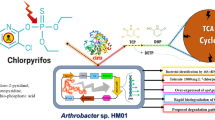Abstract
Our previous study found that Stenotrophomonas maltophilia CGMCC 1.1788 could hydroxylate imidacloprid (IMI) to 5-hydroxy IMI. Here we first report that S. maltophilia CGMCC 1.1788 can demethylate acetamiprid (AAP) to form IM 2-1 that was characterized by HPLC-MS/MS and NMR. IM 2-1 retained only 10.5% contact activity and 13.1% oral activity of AAP against horsebean aphid. Time course of biotransformation under existing of sucrose revealed that 58.9% of AAP disappeared, but only 16.7% of reduced AAP was transformed to IM 2-1, after 8 days. Both demethylation and degradation of AAP contribute to the weak bioefficacy of AAP in soil application. The differences in metabolism and detoxification pathways between AAP and IMI are probably originated from the structural differences of these insecticides.





Similar content being viewed by others
References
Buchholz A, Nauen R (2001) Translocation and translaminar bioavailability of two neonicotinoid insecticides after foliar application to cabbage and cotton. Pest Manag Sci 58:10–16
Brunet J, Badiou A, Belzunces L (2005) In vivo metabolic fate of [14C]-acetamiprid in six biological compartments of the honeybee Apis mellifera L. Pest Manag Sci 61:742–748
Dai YJ, Yuan S, Ge F, Chen T, Xu SC, Ni JP (2006) Microbial hydroxylation of imidacloprid for the synthesis of highly insecticidal olefin imidacloprid. Appl Microbiol Biotechnol 71:927–934
Dai YJ, Chen T, Ge F, Huan Y, Yuan S, Zhu FF (2007) Enhanced hydroxylation of imidacloprid by Stenotrophomonas maltophilia upon addition of sucrose. Appl Microbiol Biotechnol 74:995–1000
Iwasa T, Motoyama N, Ambrose JT, Roe RM (2004) Mechanism for the differential toxicity of neonicotinoid insecticides in the honey bee, Apis mellifera. Crop Prot 23:371–378
Matsuzaki F, Wariishi H (2004) Functional diversity of cutochrome P450s of the white-rot fungus Phanerochaete chrysosporium. Biochem Biophys Res Commun 324:387–393
Nauen R, Tietjen K, Wagner K, Elbert A (1998) Efficacy of plant metabolites of imidacloprid against Myzus persicae and Aphis gossypii (Homoptera: Aphididae). Pestic Sci 52:53–57
Nauen R, Ebbinghaus-Kintscher U, Salgado VL, Kaussmannb M (2003) Thiamethoxam is a neonicotinoid precursor converted to clothianidin in insects and plants. Pestic Biochem Physiol 76:55–59
Nauen R, Rechmann U, Armborst S, Stupp HP, Elbert A (1999) Whitefly-active metabolites of imidacloprid: biological efficacy and translocation in cotton plants. Pestic Sci 55:265–271
Palumbo J, Mullis C, Reyes F, Amaya A, Ledesma L (1999) Application and timing of insecticides for aphid management in head lettuce. Veg Rep 143:25–31
Rouchaud J, Gustin F, Wauters A (1994) Soil biodegradation and leaf transfer of insecticide imidacloprid applied in seed dressing in sugar beet crops. Bull Environ Contam Toxicol 53:344–350
Sato A, Watanabe T, Watanabe Y, Harazono K, Fukatsu T (2002) Screening for basidiomycetous fungi capable of degrading 2,7-dichlorodibenzo-p-dioxin. FEMS Microbiol Lett 213:213–217
Suchail S, Debrauwer L, Belzunces LP (2004) Metabolism of imidacloprid in Apis mellifera. Pest Manag Sci 60:291–296
Sutton D, Butler AM, Nadin L, Murray M (1997) Role of CYP3A4 in human hepatic diltiazem N-demethylation: inhibition of CYP3A4 activity by oxidized diltiazem metabolites. J Pharm Exp Ther 282:294–300
Tokieda M, Ozawa M, Kobayashi S, Gomyo T (1997) Method for determination of total residues of the insecticide acetamiprid and its metabolites in crops by gas chromatography. Nihon Noyaku Gakkaishi (J Pestic Sci) 22:77–83
Tokieda M, Ozawa M, Gomyo T (1999a) Methods of determination of acetamiprid and its degradation products in soil by gas chromatography. J Pestic Sci 24:181–185
Tokieda M, Ozawa M, Kobayashi S, Gomyo T, Takeda M (1999b) Research on the actual residues for acetamiprid in crops and soils. Nihon Noyaku Gakkaishi (J Pestic Sci) 24:115–122
Urlacher V, Lutz-Wahl S, Schmid R (2004) Microbial P450 enzymes in biotechnology. Appl Microbiol Biotechnol 64:317–325
Venkatakrishnan K, von Moltke LL, Duan SX, Fleishaker JC, Shader RI, Greenblatt DJ (1998) Kinetic characterization and identification of the enzymes responsible for the hepatic biotransformation of adinazolam and N-desmethyladinazolam in man. J Pharm Pharmacol 50:265–274
Acknowledgments
We are thankful for the support from the Key Basic Research Program of Jiangsu Higher Education Institution of China (06KJA21016), the Natural Science Foundation of Jiangsu Higher Education Institution of China (04KJB180071), and the Natural Science Foundation of Jiangsu, China (BK2006574).
Author information
Authors and Affiliations
Corresponding author
Additional information
Chen Ting and Yi-Jun Dai are co-first authors.
Rights and permissions
About this article
Cite this article
Chen, T., Dai, YJ., Ding, JF. et al. N-demethylation of neonicotinoid insecticide acetamiprid by bacterium Stenotrophomonas maltophilia CGMCC 1.1788. Biodegradation 19, 651–658 (2008). https://doi.org/10.1007/s10532-007-9170-2
Received:
Accepted:
Published:
Issue Date:
DOI: https://doi.org/10.1007/s10532-007-9170-2




